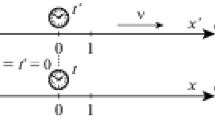Summary
The power of the four-dimensional symmetry of taiji relativity is demonstrated through an analysis of Edwards’ transformation based on the weaker postulate that only the two-way speed of light is a universal constant. His transformation, involving Reichenbach’s time, is shown to be inconsistent with Lorentz-group properties and the relativistic energy-momentum expression for particles. However, using the symmetry of taiji relativity as a guiding principle, we can obtain a new four-dimensional transformation which does not have these difficulties. We show that Reichenbach’s concept of time is compatible with the four-dimensional symmetry of physical laws. No known experiments can distinguish physical laws in this four-dimensional formalism («extended relativity») from those in special relativity.
Similar content being viewed by others
References
Yang C. N.,Phys. Today,33 (1980) 42.
Grossman N., Heller K., James C. et al, Phys. Rev. Lett,59 (1987) 18.
Sakurai J. J.,Invariance Principle and Elementary Particles (Princeton University Press, Princeton) 1964, p. v.
Edwards W. F.,Am. J. Phys.,31 (1963) 482;Reichenbach H.,The Philosophy of Space and Time (Dover, New York, N.Y.) 1958. Edwards’ transformation of space and time (2.8) was rederived and discussed by several authors. See, for example,Winnie J. A.,Philos. Sci,37 (1970) 81, 223;Yuan-zhong Zhang,Experimental Foundations of Special Relativity (Science Publishers, Peking) 1979, pp. 14–21;Gen. Relativ. Gravit.,27 (1995) 475.
For a detailed discussion of the universal constant of the one-way speed of light and its implications, seeHsu J. P.,Nuovo Cimento B,74 (1983) 67;88 (1985) 140;89 (1985) 30;Phys. Lett. A,97 (1983) 137;Hsu J. P. andWhan C.,Phys. Rev. A,38 (1988) 2248, Appendix.
Pauli W.,Theory of Relativity (Pergamon, London) 1958, pp. 5–9 and references therein.
Hsu L. andHsu J. P.,Nuovo Cimento B,111 (1996) 1283; (it is the preceding article in this issue);Experimental tests of a new Lorentz-invariant dynamics based solely on the first postulate of relativity. -II, UMassD preprint (1995).
Hsu J. P. andHsu L.,Phys. Lett. A,196 (1994) 1.
See, for example,Bjorken J. D. andDrell S. D.,Relativistic Quantum Mechanics (McGraw-Hill, New York, N.Y.) 1964, pp. 261–268 and 285–286;Sakurai J. J.,Advanced Quantum Mechanics (Addison-Wesley, Reading, Mass.) 1967, pp. 171–172 and 181–188.
Author information
Authors and Affiliations
Rights and permissions
About this article
Cite this article
Hsu, L., Hsu, JP. & Schneble, D.A. Four-dimensional symmetry of taiji relativity and coordinate transformations based on a weaker postulate for the speed of light. - I. Nuov Cim B 111, 1299–1313 (1996). https://doi.org/10.1007/BF02742507
Received:
Accepted:
Published:
Issue Date:
DOI: https://doi.org/10.1007/BF02742507




